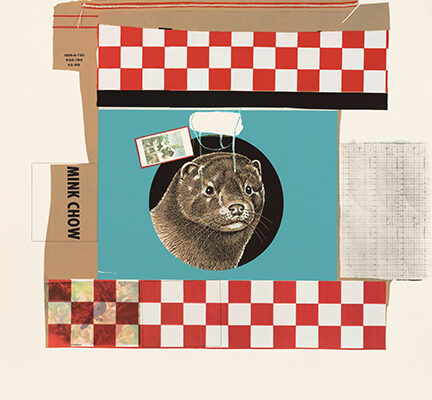Joshua Russell, PhD, was, with Kat Poje, a 2022 Regan Research Fellow at North Carolina State University Libraries Animal Rights Archive. In this article, Joshua reflects on what he’s gleaned so far from the more than 9,000 images (!) he captured in the archives.
What Nine Thousand Images Tells Me (So Far)
by Joshua Russell, PhD
In July 2022, I spent four weeks at NC State working through a huge amount of material that the amazing staff had pulled for me from the various Animal Rights & Welfare archives. In total, I captured over 9,000 images of items in the archives from as early as the 1890s up to the present day. My original proposal was to look at “archival materials that address and explain perspectives on animal ethics and moral responsibility to children as well as those aimed at parents and educators.” I situated that within the context of a long-term project on children’s experiences of animal death that I have been engaged in for several years. Knowing the context of this larger project, the library staff also pulled several boxes of materials for me from NC State’s archives in Cooperative Extension, including 4-H and the FFA.
I am currently still in the process of analyzing and tagging the many archival materials I collected last July. I have research assistants helping me with this project, and it will take some more time certainly to reach a point where I have publishable work. However, I can identify at least a few of the themes that have clearly emerged thus far. These themes aren’t fully realized and they certainly demonstrate many intersecting elements.
- Children have long been situated as central to the animal protection movements.
Even looking at late nineteenth and early twentieth century periodicals such as Our Dumb Animals, children and childhood are positioned as key subjects or periods of intervention around human–animal relations from a moral perspective. This is not entirely surprising, given that the connection between childhood cruelty to animals and adult delinquency or criminality had been expressed in Europe for centuries. William Hogarth’s famous engravings, “The Four Stages of Cruelty,” depict various life stages in a fictional character named Tom Nero, starting with his abuse of dogs and horses and ending in Nero’s committal of murder and his execution.
However, those early concerns with childhood animal cruelty were less focused on the rights or welfare on animals than they were on the preservation of social order and the avoidance of crime. This emphasis is sometimes echoed in Our Dumb Animals, when George Ansell (founder of the MSPCA) writes about the importance of teaching children kindness in order to instill in them a general sense of morality. Ansell also writes about lower rates of arson and crime, and lower insurance rates, as a positive outcome of teaching children kindness toward animals, especially boys. I will connect this at some point to theme number two as well. Yet, even Ansell was more concerned with the humane treatment of animals than earlier writers, and so kindness toward animals at this point was also about our ethical responsibility to animals themselves.
This also emerges in earlier archival materials that emphasized cruelty and suffering in animals, certainly influenced by the tradition of utilitarianism articulated by Jeremy Bentham and others. I am continuing to look at the nuance of these shifts in focus, as I think it is important to identify where and when these materials promote humane education and the teaching of kindness to children as a human social good and when they are promoting wellbeing for animals.
This theme also revolves around more contemporary materials that I discovered, which often position children as responsible for animal protection and welfare. For example, I came across an activity book that included pages for children to color that said, “Are Litters Born at Your Place? Then YOU Are the Problem,” and included silhouettes of a cat, a dog, and a person for a child to color. Another coloring book page had a child pointing a gun at a songbird and said “I’m Mattilda Mockingbird… Why is that little boy pointing that gun at me? I didn’t hurt him. What will happen to my babies? Color me scared.” Another photo on the same page has a picture of the dog, with a paragraph indicating that the boy not only killed the bird, but as a result a mosquito didn’t get eaten by the bird, and so the dog got heartworm and got sick. The blame is placed on the boy.
This is a confusing and yet also very strong message for children. There are, of course, also examples of materials that emphasize to children that they can influence the decision-making of their parents and guardians. As I continue this analysis, these areas of nuance will emerge more clearly around organizational type, time-period, or topic. However, at this early stage I can see this theme appears broadly throughout the materials I have collected from the archives.
- Children’s Relationships with Animals Are Often Discussed in the Context of Citizenship
Drawing on some of the materials I spoke of in theme one, many of the references to teaching children about kindness and compassion toward animals emphasize becoming “good” adults, contributing members of society, or citizens of a more just world. This is a reference to citizenship broadly, that is learning and possessing social virtues, neighborliness, moral responsibility, etc. However, citizenship is also often referenced as an active process, where one engages in political endeavors, civic responsibilities, and more. Materials I searched explored the role of child–animal relationships in all kinds of citizenship, including national citizenship and American identity.
As noted in the previous theme, citizenship emerges in many of the Humane Education Society, ASPCA, and SPCA materials. However, during the 80s and 90s, when a growing movement around alternative educational activities to dissection in classrooms emerged, civic engagement was encouraged among secondary and post-secondary youth, recognizing that often students’ protests should be taken to the level of regional or state governments. In fact, many of the materials that I looked at that address some form of activism clearly connect children and young people’s ethical views on animals to civic engagement and citizenship.
The other area that contributes a lot of examples here comes from some of the cooperative extension materials I was given, especially those from 4-H and FFA. In shaping this narrative around child–animal relationships and notions of citizenship, children’s relationships with agricultural animals (livestock) has always been deeply tied to their citizenship in the community, state, and for the nation. A lot of 4-H materials and FFA materials describe these educational activities as a matter of national identity, pride, and survival of the country. While the explicit descriptions of ethics here are often lacking, there are plenty of implicit ways to interpret the moral standing of animals here. A view of animal welfare coincides with goals of increased production and efficiencies throughout these materials.
I am quite excited to write up this particular theme, which I think could be a stand-alone paper and presentation. During my PhD, I took a course in moral education, and citizenship education was a big part of that coursework. It has been interesting to revisit some of those ideas and concepts of American identity, civic engagement, and responsibility all stemming from very different ways of framing child–animal relationships. I know that I collected some conservation-focused materials as well, and because of the North American Model of Wildlife Conservation rooted in hunting and fishing, that some of those materials will contribute to this complex and interesting picture of citizenship education and moral responsibility.
- Existing Projects and Other Emergent Themes
The materials I am analyzing from the archives support some of my existing work, and in particular I found a few things from the archives that I am trying to incorporate into a paper that I was already working on regarding children’s experiences of hunting and fishing. Providing some historical context only enriches that existing work around pet death, hunting/fishing cultures, and agricultural education that I have been doing over the years.
There are other emerging themes and patterns I am noticing in the 9,000 materials I gathered, as I work my way through them. Some of these themes are related to children’s own descriptions of animal ethics, recommendations on parenting (and children’s influences on their parents), and pedagogical strategies for teaching morality in humane education, and certainly there are going to be more refined analyses that can be done on types of materials and the moral language that they use to introduce welfare or rights concepts to children. Similarly, the ways in which animals are categorized differs across time and across the various movements, programs, and institutions that I am looking at in the archives.
Overall, I am excited to continue this work and to deepen my analysis moving forward. Again, thank you to the staff at NC State and the board at Culture & Animals Foundation for this tremendous opportunity.





